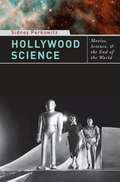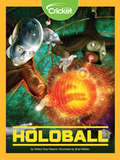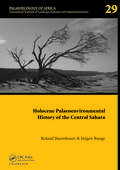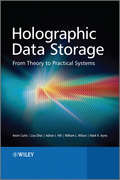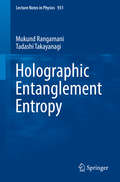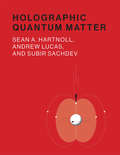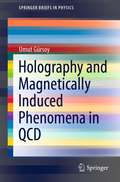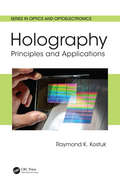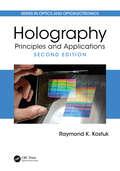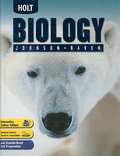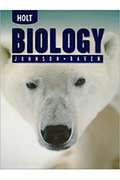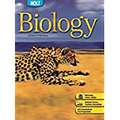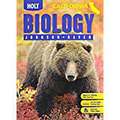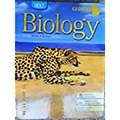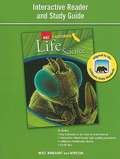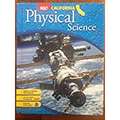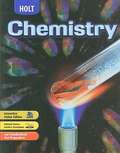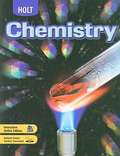- Table View
- List View
Hollywood Science: Movies, Science, and the End of the World (Acs Symposium Ser. #1139)
by Sidney PerkowitzWhether depicting humans battling aliens or a brave geologist saving lives as a volcano erupts, science-fiction films are an exciting visual and sensuous introduction to the workings of science and technology. These films explore a range of complex topics in vivid and accessible ways, from space travel and laser technology to genetic engineering, global warming, and the consequences of nuclear weaponry. Though actual scientific lab work might not be as exciting, science fiction is an engaging yet powerful way for a wide audience to explore some of the most pressing issues and ideas of our time.In this book, a scientist and dedicated film enthusiast discusses the portrayal of science in more than one hundred films, including science fiction, scientific biographies, and documentaries. Beginning with early films like Voyage to the Moon and Metropolis and concluding with more recent offerings like The Matrix, War of the Worlds, A Beautiful Mind, and An Inconvenient Truth, Sidney Perkowitz questions how much faith we can put into Hollywood's depiction of scientists and their work; how accurately these films capture scientific fact and theory; whether cataclysms like our collision with a comet can actually happen; and to what extent these films influence public opinion about science and the future. Movies, especially science-fiction films, temporarily remove viewers from the world as they know it and show them the world as it might be, providing special perspective on human nature and society. Yet "Hollywood science" can be erroneous, distorting fact for dramatic effect and stereotyping scientists as remote and nerdy, evil, or noble, doing little to improve the relationship between science and society. Bringing together history, scientific theory, and humorous observation, Hollywood Science features dozens of film stills and a list of the all-time best and worst science-fiction movies. Just as this genre appeals to all types of viewers, this book will resonate with anyone who has been inspired by science-fiction films and would like to learn how fantasy compares to fact.
Holoball
by Hillary Grey FleenorGet ready for your first holoball match! Jojo is the newest member on his team. He’s had to make lots of changes so he can play—he’s a cyborg now, which means he’s part human and part robot! His new additions allow him to see and play with holograms and have the entire internet available to him at all times. He must work together with his teammates to outwit the other team and score a victory!
Holocene Palaeoenvironmental History of the Central Sahara: Palaeoecology of Africa Vol. 29, An International Yearbook of Landscape Evolution and Palaeoenvironments (Palaeoecology of Africa)
by Jürgen Runge Roland BaumhauerThe environmental setting within the Central Sahara was subject to considerable changes during Late Quaternary, mainly driven by major global climate variations, although human impact increased constantly since Early Holocene.Such global events can be reconstructed with the help of reliefs, sediments and palaeosoils and their specific morphological
Holographic Data Storage
by Adrian Hill William Wilson Lisa Dhar Mark Ayres Kevin CurtisHolographic Data Storage: From Theory to Practical Systems is a primer on the design and building of a holographic data storage system covering the physics, Servo, Data Channel, Recording Materials, and optics behind holographic storage, the requirements of a functioning system, and its integration into "real-life" systems. Later chapters highlight recent developments in holographic storage which have enabled readiness for commercial implementation and discuss the general outlook for the technology, including the transition from professional to consumer markets and the possibilities for mass reproduction.
Holographic Duality in Condensed Matter Physics
by Yan Liu Jan Zaanen Ya-Wen Sun Koenraad SchalmA pioneering treatise presenting how the new mathematical techniques of holographic duality unify seemingly unrelated fields of physics. This innovative development morphs quantum field theory, general relativity and the renormalisation group into a single computational framework and this book is the first to bring together a wide range of research in this rapidly developing field. Set within the context of condensed matter physics and using boxes highlighting the specific techniques required, it examines the holographic description of thermal properties of matter, Fermi liquids and superconductors, and hitherto unknown forms of macroscopically entangled quantum matter in terms of general relativity, stars and black holes. Showing that holographic duality can succeed where classic mathematical approaches fail, this text provides a thorough overview of this major breakthrough at the heart of modern physics. The inclusion of extensive introductory material using non-technical language and online Mathematica notebooks ensures the appeal to students and researchers alike.
Holographic Entanglement Entropy
by Mukund Rangamani Tadashi TakayanagiThis book provides a comprehensive overview of developments in the field of holographic entanglement entropy. Within the context of the AdS/CFT correspondence, it is shown how quantum entanglement is computed by the area of certain extremal surfaces. The general lessons one can learn from this connection are drawn out for quantum field theories, many-body physics, and quantum gravity. An overview of the necessary background material is provided together with a flavor of the exciting open questions that are currently being discussed. The book is divided into four main parts. In the first part, the concept of entanglement, and methods for computing it, in quantum field theories is reviewed. In the second part, an overview of the AdS/CFT correspondence is given and the holographic entanglement entropy prescription is explained. In the third part, the time-dependence of entanglement entropy in out-of-equilibrium systems, and applications to many body physics are explored using holographic methods. The last part focuses on the connection between entanglement and geometry. Known constraints on the holographic map, as well as, elaboration of entanglement being a fundamental building block of geometry are explained. The book is a useful resource for researchers and graduate students interested in string theory and holography, condensed matter and quantum information, as it tries to connect these different subjects linked by the common theme of quantum entanglement.
Holographic Quantum Matter (The\mit Press Ser.)
by Subir Sachdev Andrew Lucas Sean A. HartnollA comprehensive overview of holographic methods in quantum matter, written by pioneers in the field. This book, written by pioneers in the field, offers a comprehensive overview of holographic methods in quantum matter. It covers influential developments in theoretical physics, making the key concepts accessible to researchers and students in both high energy and condensed matter physics. The book provides a unique combination of theoretical and historical context, technical results, extensive references to the literature, and exercises. It will give readers the ability to understand the important problems in the field, both those that have been solved and those that remain unsolved, and will enable them to engage directly with the current literature. The book describes a particular interface between condensed matter physics, gravitational physics, and string and quantum field theory made possible by holographic duality. The chapters cover such topics as the essential workings of the holographic correspondence; strongly interacting quantum matter at a fixed commensurate density; compressible quantum matter with a variable density; transport in quantum matter; the holographic description of symmetry broken phases; and the relevance of the topics covered to experimental challenges in specific quantum materials. Holographic Quantum Matter promises to be the definitive presentation of this material.
Holography and Magnetically Induced Phenomena in QCD (SpringerBriefs in Physics)
by Umut GürsoyThis book introduces the traditional and novel techniques required to study the thermodynamic and transport properties of quark–gluon plasma. In particular, it reviews the construction of improved holographic models for QCD-like confining gauge theories and their applications in the physics of quark–gluon plasma. It also discusses the recent advances in the development of hydrodynamic techniques, especially those incorporating the effects of external magnetic fields on transport. The book is primarily intended for researchers and graduate students with a background in quantum field theory and particle physics but who may not be familiar with the theory of strong interactions and holographic and hydrodynamic techniques required to study said interactions.
Holography: Principles and Applications (Series in Optics and Optoelectronics #7233)
by Raymond K. KostukThis self-contained treatment of the principles, techniques, and applications of holography examines theory and practice, image analysis, specialized techniques, and a range of applications of both analog and digital holographic methods. The author, an esteemed professor in the field, describes the nature of holographic and lithographic diffraction gratings and the tools necessary for their design and analysis. Suitable for researchers and graduate students in physics and optics, the book includes exercise problems to enhance understanding. Features Offers a systematic, rigorous account of the principles, techniques, and applications of holography Draws on the experience and lectures of a well-known author and professor in the field Presents the theory and applications of both analog and digital holographic methods Includes exercise problems
Holography: Principles and Applications (Series in Optics and Optoelectronics)
by Raymond K. KostukHolography: Principles and Applications provides a comprehensive overview of the theory, practical considerations, and applications of holography. The author has spent his career working on different aspects of this subject and, in this book, conveys the foundation for others to use holography and holographic concepts in a variety of important applications. Special emphasis is placed on the analysis of the imaging and diffraction efficiency properties of holographic optical elements that are finding increasing use in medical imaging, solar conversion systems, and augmented reality eyewear. A comprehensive overview of holographic materials is also given as this area is critical for implementing successful holographic designs. The important areas of digital and computer- generated holography are also presented to give the reader an understanding of these topics. The author has attempted to explain each subject in a manner that he has found effective in teaching holography for over 36 years.This book is suitable for researchers and as a textbook for graduate students in optics, physics, and engineering. As an aid to instructors and students, the book includes exercise problems and a set of laboratory experiments to enhance understanding. Methods for preparing and handling holographic materials are also provided to help individuals develop experimental capability in holography. In addition, over 470 current and foundational references are provided to help the researcher probe further into this interesting and useful subject.New Content in the Second Edition:• Extensive discussion of holographic photopolymers in Chapter 8.• Extended discussion of holographic optical elements in Chapter 9 with in depth analysis of waveguide coupling HOEs for augmented reality and solar concentrator applications.• A new Appendix F that covers replication and hologram parameter optimization.• Revised and extended exercise problems and laboratory experiments with solutions available from the publisher to qualified users.
Holt Biology
by Holt Rinehart WinstonHolt Biology helps students become more successful in science.
Holt Biology (California edition)
by George B. Johnson Peter H. RavenIn the study of biology, certain broad themes emerge that both unify living things and help explain biology as a science. The word science comes from Latin for "to know." Science is a systematic process of inquiry. As you study the science of biology by reading this textbook, you will repeatedly encounter these themes.
Holt Biology (Florida Edition)
by George B. Johnson Peter H. RavenHigh school biology textbook for students in Florida.
Holt Biology (Georgia Edition)
by Michael R. Heithaus Rob Desalle"You might notice that there are many unique elements in this textbook. By reading the next few pages, you will learn how the different parts of this textbook will help you to become a successful science student. You may be tempted to skip this section, but you should read it. This textbook is an important tool in your exploration of science. Like any tool, the more you know about how to use this textbook, the better your results will be. "
Holt Biology (Oklahoma Edition)
by George B. Johnson Peter H. RavenAmong the topics covered in this book are cell biology, genetics, evolution, ecology, exploring diversity, plants, invertebrates, vertebrates and human biology.
Holt Biology (Texas Edition)
by George B. Johnson Peter H. RavenThis Texas edition contains unit lessons of Principles of Cell Biology, Principles of Genetics, Principles of Evolution, Principles of Ecology, Exploring Diversity, Exploring Plants, Exploring Invertebrates, Exploring Vertebrates and Exploring Human Biology.
Holt California Life Science: Interactive Reader and Study Guide
by Holt Rinehart Winston StaffA must have science study guide dedicated to every student whose goals are towards success, acquiring knowledge and good grades.
Holt Chemistry (California Edition)
by Salvatore Tocci R. Thomas Myers Keith B. OldhamHolt Chemistry California is in line with California test standards. In this book you will see three things: what the standard actually says, what it means, and an explanation to help you understand it.
